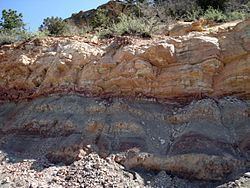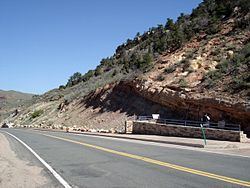Type Geologic formation Country USA | Named for Morrison | |
 | ||
Other Mudstone, Sandstone, Siltstone, Limestone | ||
Morrison formation dinosaurs and fossils
The Morrison Formation is a distinctive sequence of Upper Jurassic sedimentary rock found in the western United States which has been the most fertile source of dinosaur fossils in North America. It is composed of mudstone, sandstone, siltstone and limestone and is light gray, greenish gray, or red. Most of the fossils occur in the green siltstone beds and lower sandstones, relics of the rivers and floodplains of the Jurassic period.
Contents
- Morrison formation dinosaurs and fossils
- Morrison formation dinosaurs trail
- Geologic History
- Fossil finds
- Sites and quarries
- Colorado
- Utah
- Wyoming
- Site comparisons
- References

It is centered in Wyoming and Colorado, with outcrops in Montana, North Dakota, South Dakota, Nebraska, Kansas, the panhandles of Oklahoma and Texas, New Mexico, Arizona, Utah, and Idaho. Equivalent rocks under different names are found in Canada. It covers an area of 1.5 million square km (600,000 square miles), although only a tiny fraction is exposed and accessible to geologists and paleontologists. Over 75% is still buried under the prairie to the east, and much of its western paleogeographic extent was eroded during exhumation of the Rocky Mountains.

It was named after Morrison, Colorado, where the first fossils in the formation were discovered by Arthur Lakes in 1877. That same year, it became the center of the Bone Wars, a fossil-collecting rivalry between early paleontologists Othniel Charles Marsh and Edward Drinker Cope.

In Colorado, New Mexico, and Utah, the Morrison Formation was a major source of uranium ore. (See Uranium mining in the United States.)

Morrison formation dinosaurs trail
Geologic History

According to radiometric dating, the Morrison Formation dates from 156.3 ± 2 million years old (Ma) at its base, to 146.8 ± 1 million years old at the top, which places it in the latest Oxfordian, Kimmeridgian, and early Tithonian stages of the late Jurassic. This is similar in age to the Solnhofen Limestone Formation in Germany and the Tendaguru Formation in Tanzania. Throughout the western United States, it variously overlies the Middle Jurassic Summerville, Sundance, Bell Ranch, Wanakah, and Stump Formations.
At the time, the supercontinent of Laurasia had recently split into the continents of North America and Eurasia, although they were still connected by land bridges. North America moved north and was passing through the subtropical regions.
The Morrison Basin, which stretched from New Mexico in the south to Alberta and Saskatchewan in the north, was formed during the Nevadan orogeny, a precursor event to later orogenic episodes that created the Rocky Mountains started pushing up to the west. The deposits from their east-facing drainage basins, carried by streams and rivers from the Elko Highlands (along the borders of present-day Nevada and Utah) and deposited in swampy lowlands, lakes, river channels and floodplains, became the Morrison Formation.
In the north, the Sundance Sea, an extension of the Arctic Ocean, stretched through Canada down to the United States. Coal is found in the Morrison Formation of Montana, which means that the northern part of the formation, along the shores of the sea, was wet and swampy, with more vegetation. Aeolian, or wind-deposited sandstones are found in the southwestern part, which indicates it was much more arid — a desert, with sand dunes.
In the Colorado Plateau region, the Morrison Formation is further broken into four sub-divisions, or members. From the oldest to the most recent, they are:
- Windy Hill Member: The oldest member. At the time, the Morrison basin was characterized by shallow marine and tidal flat deposition along the southern shore of the Sundance Sea.
- Tidwell Member: The Sundance Sea receded to Wyoming during this member and was replaced by lakes and mudflats.
- Salt Wash Member: The first purely terrestrial member. The basin was a semi-arid alluvial plain, with seasonal mudflats.
- Brushy Basin Member: Much finer-grained than the Salt Wash Member, the Brushy Basin Member is dominated by mudstone rich in volcanic ash. Rivers flowed from the west into a basin that contained a giant, saline alkaline lake called Lake T'oo'dichi' and extensive wetlands that were located just west of the modern Uncompahgre Plateau.
Deposition in the Morrison Formation ended about 147 Ma. The latest Morrison strata are followed by a thirty-million year gap in the geologic record. The overlying units are the Lower Cretaceous Cedar Mountain, Burro Canyon, Lytle, and Cloverly Formations.
Fossil finds
Though many of the Morrison Formation fossils are fragmentary, they are sufficient to provide a good picture of the flora and fauna in the Morrison Basin during the Kimmeridgian. Overall, the climate was dry, similar to a savanna but, since there were no angiosperms (grasses, flowers, and some trees), the flora was quite different. Conifers, the dominant plants of the time, were to be found with ginkgos, cycads, tree ferns, and horsetail rushes. Much of the fossilized vegetation was riparian, living along the river flood plains. Insects were very similar to modern species, with termites building 30 m (100 ft.) tall nests. Along the rivers, there were fish, frogs, salamanders, lizards, crocodiles, turtles, pterosaurs, crayfish, clams, and monotremes (prototherian mammals, the largest of which was about the size of a rat).
The dinosaurs were most likely riparian, as well. Hundreds of dinosaur fossils have been discovered, such as Allosaurus, Camptosaurus, Ornitholestes, several stegosaurs comprising at least two species of Stegosaurus and the slightly older Hesperosaurus, and the early ankylosaurs, Mymoorapelta and Gargoyleosaurus, most notably a very broad range of sauropods (the giants of the Mesozoic era). Since at least some of these species are known to have nested in the area (Camptosaurus embryoes have been discovered), there are indications that it was a good environment for dinosaurs and not just home to migratory, seasonal populations.
Sauropods that have been discovered include Diplodocus (most famously, the first nearly complete specimen of D. carnegii, which is now exhibited at the Carnegie Museum of Natural History, in Pittsburgh, Pennsylvania), Camarasaurus (the most commonly found sauropod), Brachiosaurus, Apatosaurus, Brontosaurus, Barosaurus, the uncommon Haplocanthosaurus and Supersaurus. The very diversity of the sauropods has raised some questions about how they could all co-exist. While their body shapes are very similar (long neck, long tail, huge elephant-like body), they are assumed to have had very different feeding strategies, in order for all to have existed in the same time frame and similar environment.
Sites and quarries
Locations where significant Morrison Formation fossil discoveries have been made include:
Colorado
Utah
Wyoming
Site comparisons
The Morrison Formation is comparable to the Tendaguru beds in Tanzania and Lourinhã Formation in Portugal. In age it is also comparable with the Solnhofen Limestone in Germany.
